 |
I had read about the largest palace in the world being in Romania (I had imagined it would be in Saudi, or somewhere like that).
The crew I met in India and I decided to have a re-union there (unfortunately, the excellent Jane couldn’t make it) and they brought other travellers with them (when I say travellers, they weren’t Gypsies, or anything like that).A great guy on the trip called Sid (his name has been changed to protect his identity) described me as John Sunter, the man that PC forgot.
I like that.
This picture was taken from the bottom of Union Boulevard, you can see the fountains, Dâmboviţa River and Parliament Palace in the background. |
| I was initially surprised at the cost of things in Bucharest, as I expected they would be much cheaper.In reality, although the rest of Romania is extremely poor, Bucharest is a thriving business capital, with commensurate prices.Our hotel was right on Calea Victoriei (Victory Road) considered the most beautiful street in Romania and first built in 1692.The Romanian Athenaeum is a landmark of the capital and opened in 1888.A portion of the construction funds was raised by a public subscription in a 28 year long process, remembered today, by the slogan “Give one lue for the Atheneum”. |
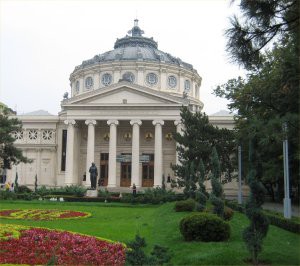 |
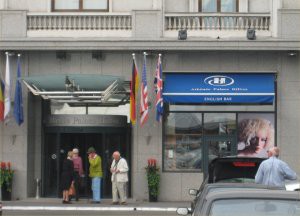 |
The Athénée Palace hotel has a history of espionage.It may well have been Europe’s most notorious den of spies in the years leading up to World War II, with British agents, as guests alongside members of the Gestapo).In 1948 the hotel was nationalized by the new Communist government, who famously bugged every room, tapped every phone (and every pay phone within half a mile), and staffed the entire hotel with informers.The doormen did surveillance; the housekeeping staff photographed all documents in the guests’ rooms, not to mention a number of the guests had been planted.The government-run Athénée Palace closed in 1994 and was bought at auction by Hilton International, who proceeded to do a $42 million renovation and expansion, reopening the hotel at nearly twice its former size in 1997. |
| The Novotel, had a clever mix of old and new.The front is a replica of the old Romanian National Theatre in roughly its original location.The “modern” national theatre, is about half a mile away. |
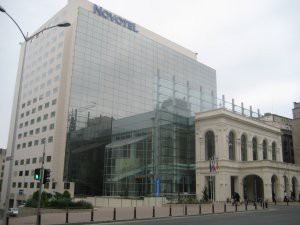 |
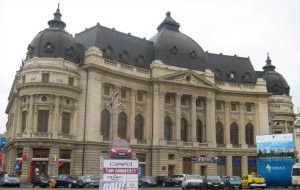 |
The Central University Library is a beautifully ornate building located opposite the Royal Palace in the Revolution Square.The library was founded by King Carol I and the building was designed by the French architect Paul Gottereau, who also designed the National Savings Bank (CEC) building.The building was heavily damaged during the December 1989 movement but was later restored.The addition of cars for sale, in front of the building, has ruined the photograph. |
| Cretulescu Church (Biserica Cretulescu) on one corner of Piata Revolutiei (Revolution Square), next to the former Royal Palace.This is the beautiful red brick Cretulescu church, one of the oldest churches in Bucharest. |
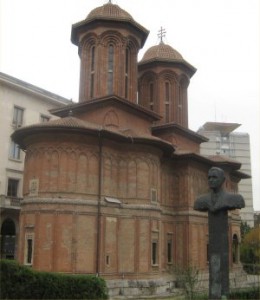 |
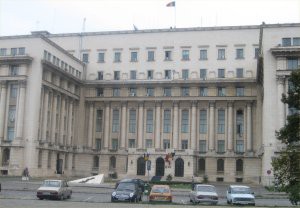 |
This is the balcony where Ceauşescu gave his last speech.He had actually arranged for a crowd to be there and cheer, and looked on helplessly, as the crowd turned on him.The balcony was a lot lower than I remember it on television at the time. |
| In front of the building, in the newly named revolution square, the rebirth memorial was constructed to commemorate the 1500 people who lost their lives during the revolution.The abstract monument sparked a great deal of controversy when it was unveiled, being dubbed with names such as “the toothpick and the olive”, as many believed that it didn’t symbolize the revolution well enough.The designer, Ghilduş, was an applied artist, previously having experience designing objects like chairs and lamps, rather than a sculptor.Owing to its relative unpopularity, the monument is guarded round-the-clock, but despite this, on the night of 12 May 2006, it was vandalized. |
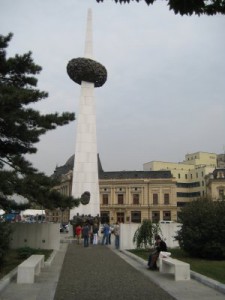 |
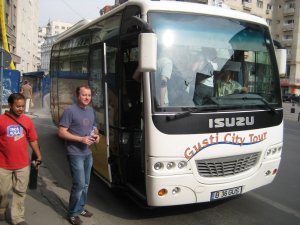 |
The Hotel advised us that they could organise a tour bus for us all (throughout the weekend, the Hotel staff were really helpful, ordering taxis, booking restaurants and stuff like that).It was decided that we would charter the bus, to get our bearings and for only a tenner each, we got a private tour around the city.Our guide spent 3 years in America, his English was excellent. |
| The Army Club (Cercul Militar National).This highly ornate building was designed in French neo-Classical style by Dumitru Maimarolu, Victor Stefanescu and Ernest Doneaud.Construction started in 1911 and ended in 1923 with most of the funds being donated by the Romanian Army officers.The green umbrellas at the front show the location of a fine terrace restaurant, open to the public. |
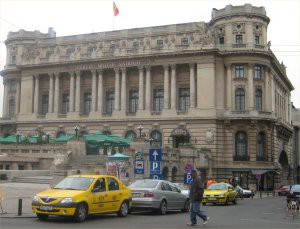 |
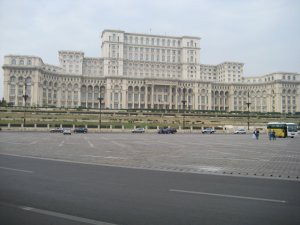 |
We stop briefly to visit the Parliament Palace (the one thing I really wanted to see in Bucharest).On our last day, we actually had a tour of the Palace, but on this occasion just stopped outside to take photo’s.From the distance, between the camera and the tour bus on the right, you can see just how far back you have to be to fit the building onto the picture. |
| National Art Museum.This imposing building used to be the Royal Palace.Starting with 1948 the palace housed the National Art Museum and it displays an extensive collection of Romanian and European art dating from the 15th to the 20th century.The building was damaged during the events of December 1989 and was closed for several years for repairs. |
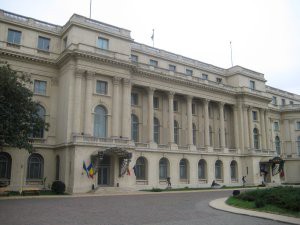 |
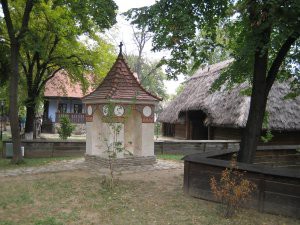 |
The Village Museum (Muzeul Satului) was established in 1936 and it contains over 300 wooden houses, windmills, churches etc. from all over the country.This museum is one of the largest of its kind in Europe and many of the buildings are originals which were brought here in pieces and reassembled.The oldest houses date as far back as the 1700’s. |
| The buildings are setup like actual villages, and then grouped according to location.This is a Transylvanian Tall house. |
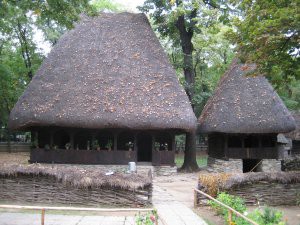 |
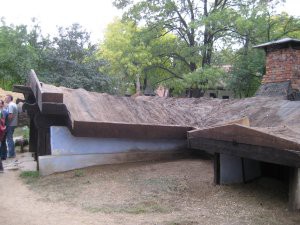 |
I found this building, the most fascinating.I cant remember where it was from, but it was actually dug underground, similar to the buildings I have heard of in Coober Peddy, Australia. |
| We wandered outside the Village museum and had a look around.I had read that there were some very nostalgic fairgrounds in Bucharest.One of the ones I found looked exactly like a fairground I visited when I was 7. |
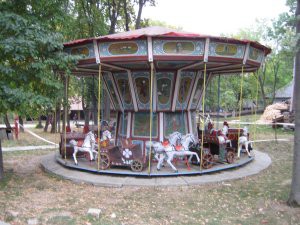 |
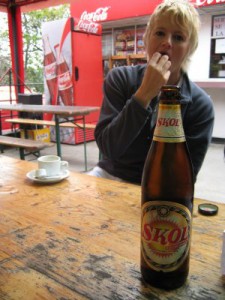 |
We continued to wander around the park, looking for something to eat/drink.There were distinct Coffee/Beer factions within the group (you can guess which one I was in).Skol hasn’t been sold in the UK for what must be 15 years so I decided to try some.It was stronger than I remember it, but just as awful !.In the background is Claire. It turned out that Claire was a Midwife, it was the first time I had ever met one (well technically the 2nd, but it was the first time I was old enough to speak !). |
| Ion Luca Caragiale Bucharest National Theatre.Half a mile from the original site, and has been in use since 1973. |
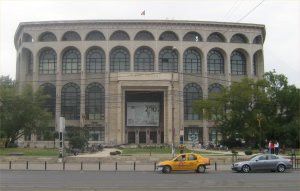 |
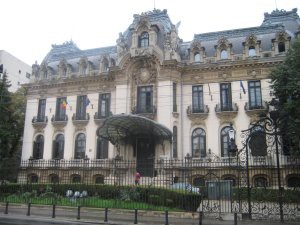 |
Cantacuzino Palace.Originally designed by the architect I.D.Berindei in French baroque style, construction was started in 1899.Above the main entrance there is a giant shell-shaped porte-cochere; two stone lions guard the entrance.George Enescu – Romania’s national composer – lived here for a period of time.The building belonged to his wife Maria Cantacuzino.Nowadays the palace houses the George Enescu Museum which displays the musicians manuscripts, compositions and personal belongings like one of his first violins. |
| The headquarters of the Architectural association in Romania.Built on the ruins of the State Security Building.The Securitate was, in proportion to Romania’s population, the largest secret police force in the Eastern block. |
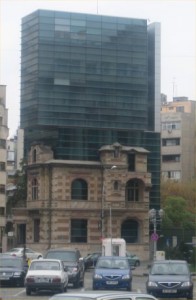 |
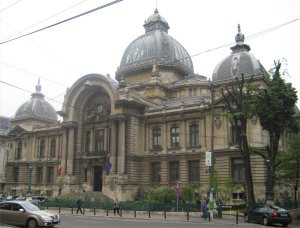 |
Romanian Savings Bank or CEC Building.This beautiful building was designed in eclectic style by the French architect Paul Gottereau.Its construction began in 1894 on the site of a 16th century monastery Sf. Ioan cel Nou.This was the only bank that was allowed to operate during communist times. |
| The Coach dropped us outside the National Museum, and we debated going in.We decided instead to wander around the Lipscani district, or old town.Only 1/5th of it, remains, the rest was demolished to build Ceauşescu Peoples Palace, and the administrative and social buildings attached to it.We found a nice bar, and had a few drinks.Afterwards, a few of us went shopping, a few exploring, and another few stayed to watch the Rugby. |
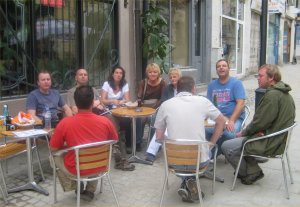 |
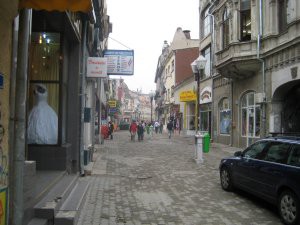 |
Lipscani was the main street of the City, for nearly 300 years, and was the inspiration, for people describing Bucharest as the Paris of the East.It’s now a narrow little curly street cut in three parts by Calea Victoriei and Bucharest’s main boulevard.It took it’s name in the old days, as many of the shops in the area used to sell different articles that had been brought from the German town Leipzig (In Romanian: Lipsca). |
| Significant work is being done to rejuvenate and repair the place, and it certainly has charm. |
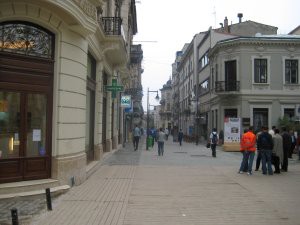 |
 |
As we wander further a field, we come across this building.Against some fairly stiff competition, this was the ugliest building I saw in Romanian.I know that I have been quoted in the past saying you don’t live on the outside of a house, you live on the inside, but no matter how superb, the soft furnishings, I don’t think I could live in this building. |
| In the evening we wandered around University Square, where the main revolution took place.It’s described as vibrant and busy 24 hours a day, and it’s certainly that.It’s reached by an underpass, so you don’t have to cross the road to reach the square.The underpass is the main meeting place within the city, and I was surprised at how comfortable I felt while in there (I normally find such places claustrophobic and unnerving).In the background is the Intercontinental Hotel which overlooks the square.I didn’t see inside, but it really is one of the most impressive hotel buildings I have ever seen outside Las Vegas.It’s also the tallest building in Bucharest. |
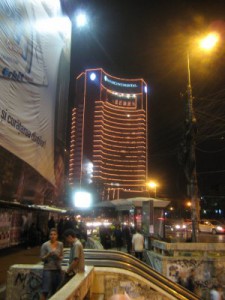 |
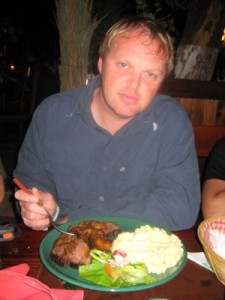 |
We visit a famous restaurant, just off the square called Burebista Vanatoresc.They specialised in traditional Romanian food.Some of my friends were eating bear (I mean the animal, they didn’t get undressed for the meal !) and stuff like that.I chose royal beef, which turned out to be a mistake.The good news was the mashed potatoes it came with were absolutely delicious.There was a wedding going on inside the restaurant, so the service was a bit “tame”.Overall though, it was a pretty cool evening, and a great chance to meet some of the new people who Angela and Paul had introduced me to. |
| Although not really a nightclub person (most of you know, I used to frequent nightclubs, only as a means to get late drinks, and that is no longer necessary in the UK).I am however, a bit of a reverse snob, and when I saw a “back street” nightclub around the corner that looked sleazy, I decided to pay a visit and a few of the crew came with me.We couldn’t have been more wrong. It was nicely painted, spotlessly clean, had table service, and served cocktails. |
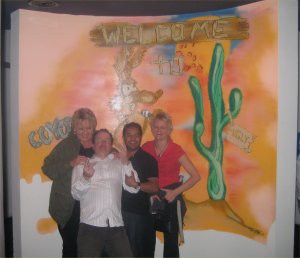 |
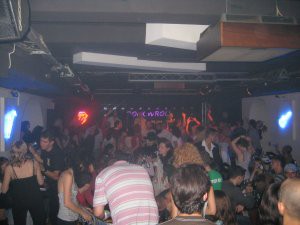 |
A live band was playing when we got in there but finished a few minutes later, which was a shame.They played the usual bing-bong 80’s stuff which is popular in eastern Europe.They also played “Winds of Change” by the Scorpions, a song synonymous in both east and west, with the ending of the cold war. |